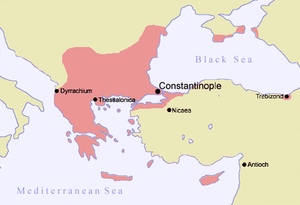Comnenian Army
The Comnenian Army was the army of the Byzantine Empire that was set up under Emperor Alexios I Komnenos in the late 11th century and expanded under his successors John II Komnenus and Manuel I Komnenos in the 12th century.
Construction and successes
At the beginning of the Komnenen rule in 1081, the Byzantine Empire was reduced to the smallest area in its history. Surrounded by enemies and financially ruined by a series of civil wars, the prospects were far from bright. Under these circumstances, together with the changes in Byzantine society, including the loss of Anatolia , the tried and tested system of themes could no longer be maintained. Emperor Alexios I Komnenus was known for his skills as a military leader and carried out several successful sieges. Under his rule, however, territories could be recaptured from the Turks . However, through a combination of determination, ability and years of campaigns, Alexios I Komnenus managed to partially restore the power of the empire by building an army from scratch. It was characterized by professionalism and discipline and comprised such outstanding units as the aforementioned Varangian Guard and the Immortals ( heavy cavalry ), who were stationed in Constantinople, as well as numerous militia units from the province. The latter also included cataphracts from Macedonia, Thessaly and Thrace, as well as various regional units from areas of Asia Minor, such as the Black Sea coast. However, the role of the Crusaders should not be forgotten , whose intervention as a result of the 1st Crusade was one of the decisive factors for the success of the Byzantine military actions.
Under John II Komnenos new troops were raised from imperial citizens in the provinces. When Byzantine Asia Minor began to flourish under John and Manuel I Komnenus , more soldiers came from the Asian parts of the empire Neokastra, Paphlagonia and even Seleukia in the southeast. Soldiers also had to be provided by defeated peoples, such as the Pechenegs (mounted archers ) and the Serbs, who were also settled in Nicomedia as settlers. Troops from Reichsuntertanen were combined into regular units and stationed in Asia as well as in Europe. In addition, there were often aid contingents from Antioch , Serbia or Hungary , but even so the Byzantines made up about two thirds of the total strength of the army, while foreigners made up the remaining third. Infantry , cavalry and archers were grouped into groups that supported each other on the principle of linked arms.
This army of the Komnenenkaiser was an efficient and well-trained armed force that fought in Hungary, Italy and Asia Minor. However, the new armed force had a decisive disadvantage compared to the traditional Byzantine armies: it was designed according to the specifications of Western martial arts and no longer possessed the superior discipline which in earlier times had often given the imperial armies the decisive advantage. Without this factor, the Byzantine army was no longer superior to its opponents. Another weakness turned out to be the fact that their effective use, like so much in the realm of the Comnen dynasty, depended on the person of the ruler and his abilities who directed their use. Under strong emperors like Alexios, Johannes II. And Manuel (around 1081–1180), the army was able to protect the empire easily, so that trade, change and culture flourished. As will be seen later, the disappearance of the competent Komnenenkaiser was largely responsible for the fact that the efficiency of the army increasingly dwindled, leaving the empire almost unprotected in a decisive phase. This ultimately gave the Byzantium of the Central Byzantine period the fatal blow.
Pronoiai
This type of troop is closely related to the Comnen period and began to emerge in the 12th century, especially during the reign of Manuel I (1143–1180). These soldiers received a piece of land instead of pay , but were not fortified farmers as in the old thematic order of the Middle Byzantine period. The Pronoiai system developed into a kind of tax tenancy that collected the taxes from the citizens (paroikoi) living within the boundaries of the assigned area and kept part of it as remuneration. Sometimes the Pronoiai are compared to western knights, who were also both warriors and sovereigns, and in fact at this time the tendencies towards feudalization within the empire also increased strongly under western influence. In contrast to the knights, however, the owner of the land allocated to the Pronoiai was still the emperor. Pronoiai troops were usually cavalrymen and were much like Western knights in their armament and equipment, with lances, swords and armor for horse and rider. With the dwindling financial possibilities of the empire after 1204, the number of Pronoiai increased more and more, especially in the Nikaia Empire .
literature
Secondary literature
- J. Birkenmeier: The development of the Komnenian army, 1081-1180
- John Haldon: Warfare, State and Society in the Byzantine World
- John Haldon: Byzantium at War
- Ian Heath: Byzantine Armies AD 1118-1461
- Warren Treadgold: A History of the Byzantine State and Society
- Terence Wise: Armies of the Crusades
- Michael Angold: The Byzantine Empire 1025-1204, Longman, Harlow Essex (1984)

